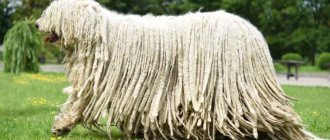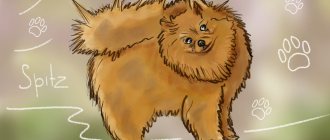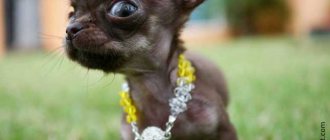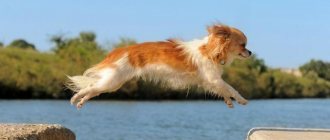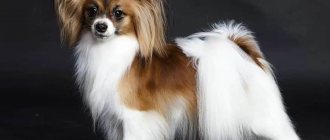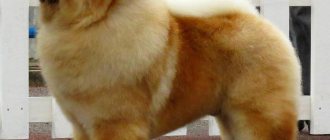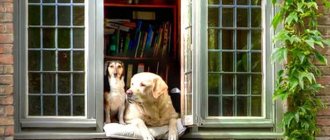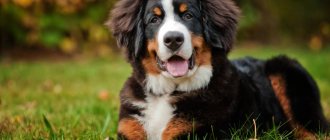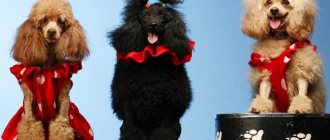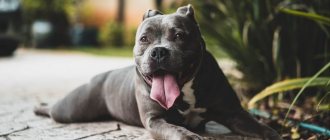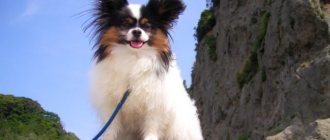There are about 400 dog breeds on Earth. Each country has its own most common and rare breeds, but there are some that are difficult to find in any corner of the planet. Among them are large and small dogs, watchmen, hunters and lap dogs - the list of the rarest ones is not due to their appearance or quality. Such breeds have a small number on a global scale, and therefore are of particular interest.
Leonberger
Leonbergers come from Germany and appeared in the 19th century. They were often presented as gifts to princes and royalty.
The Leonberger is a large, muscular dog, 80 cm tall at the withers and weighing 50 kg. The fur is thick and soft, with panties and a mane, just like a lion's. Outwardly, dogs look harsh, but they have a gentle and kind heart.
The number of Leonbergers is small. The wars that affected Germany and the difficult post-war period affected the history of the breed. She mixed with others and lost many of her characteristic features. However, now breeders are focused on restoring the standard, and every year the number of true Leonbergers is increasing.
Bonus: Australian bobtail heeler
This breed is also known as the Australian Short-tailed Cattle Dog and we couldn't help but include it on our list. The blood of Australian dingoes, English Smithfields and marbled smooth collies runs through their veins. As a result, representatives of the newly created breed received amazing color, character and abilities.
The Australian bobtail heeler is extremely hardy and intelligent - it is a versatile herding dog. They practically do not bark, and to control animals they bite their hind limbs, after which they bend down, avoiding a retaliatory kick. For this feature the breed got its name, from the English “heels” - “heels”, that is, literally translated - “heel”.
Today the breed numbers about four thousand individuals, but you will hardly find them outside of Australia. It's all about the peculiarities of upbringing - dingo blood makes heelers distrustful and requiring especially careful training, so breeders simply do not give the dogs to amateurs.
Representatives of all the breeds described above have several characteristic features in common: these are representatives of old breeds, in the past they performed important functions for humans, they require experience and skills in training. In addition, they are not popularized through the media. For example, the film adaptation of Hachiko’s story increased the popularity of the Akita Inu breed by about 100 thousand times. The situation is similar with breeds of “pocket” dogs. We can only hope that the breeds described in this material will also gain popularity and will multiply, delighting their owners with intelligence, skills and independence.
Tibetan mastiff
There are very few real Tibetan mastiffs. Purebred representatives can be found in the foothills of Tibet and among rare breeders. Most puppies that are passed off as the right breed are mixed with other dogs.
The Tibetan Mastiff is one of the oldest breeds. Presumably, all herding dogs descended from her. Initially, dogs were used to guard monasteries and as companions of nomads on hikes in the Himalayas. They appeared in Europe only in the middle of the 19th century.
Dogs grow up to 77 cm and weigh up to 80 kg. They are famous for their thick coat, which allows them to live outdoors even without a kennel. Color red, black and brown.
Genetic conditioning
The appearance of the fur of tetrapods is determined by different genes. Some of them are responsible for the fusion of the substances eumelanin and pheomelanin. Other genes distribute these elements throughout the pet's coat and body.
There is a hereditary predisposition that determines the intensity of the basic tone and spottiness of the fur. The main genes responsible for the tone of the coat are genes A, C, B, D, E, G, M.
Their combination forms the color and pattern on the body of the four-legged friend. Genes are able to combine in different combinations, distributing pigment and spotting throughout the body. Experienced breeders, having seen the parents of the future puppy, are able to calculate the baby’s exterior, even if he is still in the womb.
The standards of some breeds contain strict rules on genetic conditioning. For example, in Europe there is a ban on dogs with Isabella color. This variant contains a combination of genes that subsequently provoke a whole range of diseases.
Chinook
The Chinook appeared in the USA at the beginning of the last century. It was bred to transport heavy loads. The narrow specialty explains that even at the time of greatest popularity, the number of Chinooks reached 300 individuals. Now the need for transporting goods has disappeared, and the breed remains small in number.
This is a large dog that is absolutely not suitable for apartment living. They weigh 42 kg, height – 70 cm, and in terms of strength and endurance they are ready to become worthy rivals to other sled dogs. Gold color.
What is color and suit in dogs
Color is the visible pigment of the outer part of the hair. In the absence of such pigment, the hair will remain white. In addition, the concept includes the intensity of the shade and the pattern created on the surface of the pet. If several colors are mixed, then the color that occupies most of the dog’s body will be called the suit.
Catalburun
The Catalburun is a Turkish breed, but even in Turkey few are familiar with it. She was bred specifically for hunting. The dog's special feature is its nose. It is distinguished not only by its special sensitivity, but also by its unusual appearance: it has a forked lobe with a deep groove.
The Catalburun is a well-built dog with short piebald hair. Height reaches 63 cm, weight – up to 25 kg.
The total number of catalburuns does not exceed 2 hundred individuals. They are in demand, but they are bred in limited numbers and only in areas that were the dogs' historical homeland.
Criteria determining the rarity of a breed
Currently, there is no officially recognized list of factors that determine the rarity of a breed . However, there are a number of criteria that influence the list of small representatives of canids.
The rarity of the breed may be due to:
- extinction (extinction of a certain type of dog);
- difficulty of breeding (need for special conditions);
- high cost;
- a small number of representatives (limited selection of genetic material), etc.
There are more than 400 dog breeds on our planet, but only 344 breeds are officially registered in the most authoritative canine association FCI. About 40 breeds remain unrecognized and poorly studied.
Thai Ridgeback
This is the Thai national breed, one of the oldest domesticated by humans. It was used for hunting small animals, protecting against thieves and protecting against snakes. The Ridgeback is also known as the Mah Tay.
Read List of the best cartoons about dogs - TOP 50
The Ridgeback is an athletically built dog that reaches a height of 61 cm and weighs 32 kg. The coat is short. Color – red, blue, black and light.
Ridgebacks have not changed for thousands of years, which is due to the isolation of Thailand and the lack of established transport links. This also influenced the popularity of the breed and its small numbers. In recent decades, the situation in the country has changed, and Ridgebacks began to find fans all over the world, and breeders are paying more attention.
Color groups
Experts divided all the variety of colors into several main groups. They include both single-color and multi-color variations of shades and patterns.
Solid
The solid color of tetrapods is distinguished by the presence of only one shade on their body. On the other hand, it may be its complete absence. The substance eumelanin forms black or chocolate pigmentation with varying degrees of saturation. The lightened form of this type is called blue or beige.
The substance pheomelanin is responsible for the red or deer variant. And the lightened form of the pigment gives a sandy background with variations from white to light cream.
Mixed
A mixed group appears by combining a pair of shades. Moreover, the white tone should not participate in the mixing. The variation in the colors of the dog is influenced by the presence of the substance eumelanin or pheomelanin. As a result of the manifestation of these two pigments, 5 types of mixed tones are distinguished:
- red with a black mask on the face;
- red with some darkening;
- brindle;
- black with reddish tan;
- red with black undertones.
All types of these variations are characterized by some lightening and a special placement of pigmented fur on the body of the four-legged friend. The mask, in turn, is combined with each of the four tones.
Modified
The mentioned groups may change with age. So, spots, bleached or piebald areas appear on the fur. However, lightened dog coat color is common in many breeds, and this is in no way due to age-related changes. It’s just that a pet is born with pigment, but over time it loses it.
This modification can be observed in combination with any base tone. For example, dark spots or variegated shades are clearly visible against gray and lightened backgrounds. This is the so-called marble tone.
White spots are formed due to a complete lack of pigmentation on certain parts of the pet’s body. There are pets that have white spots located almost all over their body, and only their ears are colored.
Pungsan
Mentions of Pungsan are common in Korean folk tales. There they are presented as smart and strong animals, capable of defeating even tigers. Representatives of the breed were bred to hunt large animals. Strength and endurance made them indispensable companions during the hunt.
Pungsans are descended from North Korean wolves. At the withers they reach 60 cm and weigh up to 25 kg. They have thick fur, which is most often colored white.
Now Pungsans live on the territory of the DPRK and it is almost impossible to meet them outside the northern part of the peninsula. Due to their small numbers, they are known only to rare dog breeders.
Norwegian Lundehund
The Norwegian Lundehund is also known by another name – the hunting husky. A distinctive feature of the representatives is the presence of a sixth toe on their paws. This helps them climb rocks and other difficult surfaces with confidence. The dogs are very flexible and resilient. They are medium in size. They have a balanced and calm disposition. They do not show aggression towards people. Now the population is falling significantly. Representatives of the breed are found in Norway. The price of puppies is about 25 thousand rubles.
Portuguese water dog
Her homeland is Portugal. The breed appeared in the Middle Ages and found use among fishermen. The dogs guarded the catch, delivered letters between ships, and helped pull drowning people out of the water. However, by the 20th century, Portuguese fishermen as a social class had practically disappeared, and the water dog along with them. At the moment, dog handlers have appreciated the merits of the breed and have begun restoration.
Adults reach 57 cm at the withers and weigh 25 kg. The coat is curly or wavy. Color black, white or mixed.
New Guinea singing dog
the rarest dogs live in the mountains . There are three indisputable facts that characterize this dog.
- It has a unique vocalization, for which it is nicknamed “singing”.
- The animal is very ancient. It exists for at least 6000 years.
- The dog, especially its life in its natural environment, has not been studied at all.
It is believed that the dog was domesticated and helped ancient people in hunting. Over time, the animal went wild again. Externally, the dog is similar to the Australian dingo. But somewhat smaller. Its weight does not exceed 15 kg. Height is about 30-45 cm at the withers.
The singing dog has a number of qualities that make it an excellent hunter. She can climb trees. Its eyes are designed so that the animal sees well in twilight or even darkness. Spending most of its life in the forest and mountains, the New Guinea dog has lost its speed qualities, but in terms of agility, dexterity and flexibility it is ahead of domestic hunting dogs.
Stabihun
The Stabyhune is a breed originally from the Netherlands. Initially, dogs were kept on farms, where they performed several types of work at once: hunting, guarding, shepherding, etc. This is a truly “universal” dog that can easily adapt to any conditions created by the owner.
The Stabyhune is a well-built and muscular, but at the same time light and agile dog. It grows up to 53 cm and weighs up to 25 kg. The coat is straight, two-colored: black and white or brown and white.
The total number is no more than 1000 representatives. This is due to the relative youth of the breed - it was bred in the middle of the 20th century, the narrowness of the region and the lack of specific traits that would attract breeders.
Keeping rare dogs
Any breed requires a special approach. Owners of the rarest Wolf representatives need to know the basic principles.
- Knowing that a rare dog is desirable, then before buying you need to carefully study the character, habits, and behavior.
- It is important to determine the reasons for the acquisition. They may be for the sake of exoticism, breeding, or because they liked the dog at first sight or because it is rare for the region.
- When keeping a puppy, you must immediately accustom him to walks and socialize him.
- This rare breed is special and has a complex character.
- Only experienced owners who know how to deal with problems of aggression and disobedience should get such a dog.
Chongqing
This rare breed comes from the province of the same name in China. Residents have long valued the Chongqing and did not allow it to mix with other breeds, thanks to which it has been preserved unchanged. The emperor and his courtiers used dogs for hunting; commoners were not allowed to have them. However, this played a cruel joke on the dogs. They became a symbol of imperial rule, and therefore many of them were killed during the revolution. The rest have lost the characteristics of the breed, and now there are practically no purebred Chongqing dogs.
This is a strong, medium-sized dog: height is 50 cm, weight – 23 kg. She has a noble color of mahogany or shades of brown.
Azawakh
We warn you, once you convince an Azawakh dog, you will most likely be dying to feed it. However, it is not by chance that individuals have such abnormal thinness; the fact is that dogs of the Azawakh breed belong to the greyhound family. They were bred in Mali, a country with a very hot climate, most of it occupied by the Sahara Desert. It is logical that dogs in this region should have had a special structure, and this is how the Azawakh breed turned out. There is no excess fatty tissue on the body, the muscles are dry and flat, the skin is thin with a large number of blood vessels. All these qualities, coupled with long limbs and a short back, allow the dog to develop high speed, and in addition, provide endurance. The Azawakh is capable of chasing game for a long time, even in extreme heat. Dogs of this breed are not very sociable and cannot live in an apartment; they need regular physical activity, which is why it is not so common.
Moody
Mudi appeared on the territory of modern Hungary in the 17th century. These are real hard workers who always happily do any work assigned to them. They were used as shepherds, rat catchers and companions.
The breed's population almost disappeared during the Second World War. Afterwards, no more than a dozen individuals remained. Over the past decades, the number has been increased to 2000.
Mudi is a light but strong dog up to 47 cm tall. Weight is no more than 13 kg. The coat is thick, straight and wavy on different parts of the body. Color – black, white, brown, ash.
Read The best herding dogs - 20 breeds and their uses
Slovak dude
The breed has been known as a mountain herding and guard dog since the 17th century. The dogs are strong and large. Males can grow up to 70 cm and gain weight up to 45 kg. The dude's proportions are correct. The body is slightly longer than tall. The stomach and sides are tightened. Legs of medium length, straight. The chest is voluminous. The proportionate head rests on a powerful neck.
The fur is thick, wavy with undercoat. Males have a noticeable fur collar. The color is exclusively white. Yellow ears are possible, but not desirable. Dudes have excellent performance, a patient, calm character, and are non-aggressive. They can act as companions.
Barbet
Author: Pleple2000 - own work, CC BY-SA 4.0,
This rare breed appeared in the 14th century in France. Barbets are also known as water dogs. This is due to their purpose: dogs were used as waterfowl hunters and to guard sea vessels.
Barbets are 47 cm tall and weigh 35 kg. They are known for their funny goatee and shaggy coat. Moreover, the colder the climate in the region of residence, the richer the wool cut.
Once upon a time, the number of barbets was truly colossal, but during the First World War and then the Second World War there were almost none left. This is due to the fact that hunters and rangers - the main breeders - went to the front, and the breed lost its characteristics. Only recently has recovery begun.
Types by location of spots
The appearance and location of the marks on the dog’s body differ in intensity and size. They can cover almost the entire body of the animal or concentrate in certain areas. Dogs with spots on their coats come in most breeds. Based on the location of the spots, they are distinguished:
- Irish spot with white markings of varying sizes that cover most of the animal's body.
- Piebald, in which there are large white areas on the head, neck, chest, tail and paws against a dark background.
- Extreme spotting with a small amount of primary color pigment. Sometimes the pet appears white with small colored areas.
- Speckling, when many small spots are visible on a white or light gray tone, the color of which depends on the main color of the dog.
- Marble with black spots of irregular geometry and different sizes on a white base.
Some breeds begin to develop a spotted pattern as they age. For example, the fur of Dalmatians only after two months of life becomes similar to the standard exterior that is familiar to people. Sometimes the appearance of spotting is associated with deviations from the characteristics of the breed.
Xoloitzcuintle
Author: Pets Adviser from Brooklyn
This is one of the oldest breeds in the world, which appeared in the 5th millennium BC. Mystical abilities have long been attributed to her: they are guides to the other world, healers who can cure a person in one day. The Aztecs sacrificed xoloitzcuintles to appease the gods. Now they are companion dogs.
They are presented in three types: miniature (30-35 cm), medium (40-45 cm) and standard (45-55 cm). The coat also differs: in one litter both hairless and short-haired puppies can appear.
For a long time, the breed was bred only in remote Mexican villages, so its numbers are small. Only in the late 1950s did breeders begin breeding her, but so far she has only gained a narrow circle of fans.
Finnish Lapphund
The Finnish Lapphund was originally used by the semi-nomadic Sami people to work with reindeer herds. These days, this breed is a popular companion in its native Finland.
Intelligent, friendly and attentive, the Finnish Lapphund makes an excellent family companion and watchdog. Its activity requires daily exercise to maintain physical and mental development. Regular exercise will prevent your dog from becoming destructive or noisy in an attempt to entertain himself.
Telomian
The dog comes from Malaysia, where it was used as a guard and hunter of rodents and snakes. It is believed to have descended from the wild dog dingo. World history began in the 1970s, when a tribal leader presented a Telomian boy and a girl to the US ambassadors.
It’s difficult to talk about breed standards; many cynological organizations have not recognized it. Height usually does not exceed 46 cm, weight reaches 20 kg. There are dogs with black, black-and-white and brown-white fur.
Telomians did not find popularity in Europe and America. They are little studied and practically uncontrolled, so purebred puppies are a rarity.
Stybehaun
The Stybehaun were developed in the Netherlands back in the 19th century. This is a hunting dog that appeared thanks to the crossing of the then popular German or French spaniels along with the Drenthe partridge breed. A strong desire to hunt manifests itself not only when going into the forest to hunt game, but also when encountering rats. They serve as rodent exterminators and guards. The rarity is due to the limited breeding sites, as they are found mainly in the Netherlands.
Basenji
The Basenji is also known as the African non-barking dog. The name is associated with their origin (their homeland is Central Africa) and the peculiarity of “communication”. Representatives of the breed do not bark, but make sounds similar to rumbling, and occasionally sing. Their history goes back more than 5 thousand years.
These are strong, lean dogs. Height – up to 43 cm, weight – up to 11 kg. The coat is short, the color varies, but the paws, chest and tip of the tail are exclusively white.
The Basenji is a breed that developed in the forests of the Congo. Despite her long-term acquaintance with people, she was known only on the African continent. In the 20th century, they became known to Europeans, but they took root poorly and won the love of only rare breeders.
pros
Breeding and restoration of rare breeds has a positive effect on the development of the population of exclusive representatives of the fauna. This kind of work helps expand our understanding of the origin of relict breeds and their role in the emergence of new dogs.
Some breeds are on the verge of extinction. Natural characteristics are lost. It is valuable that the rare breed has not been subjected to selection. Known since ancient times, they have retained all those qualities that were most valued.
The absence of closely related crosses excludes genetic defects and mutations.
Bedlington Terrier
Author: David Owsiany
This dog comes from Britain, and the first mention of it is found in the 19th century. Once upon a time she was indispensable for the British: she hunted small animals, caught rats, and acted as a companion.
The height of the Bedlington Terrier does not exceed 42 cm, weight – 10 kg. Outwardly, it looks like a sheep: its wool consists of small light curls.
Bedlingtons have always enjoyed the attention of aristocrats and hunters and were included in the list of the most expensive dogs. However, there has never been a great demand for them, which is why the breed is quite rare.
Pitbull Merle color
If you are suddenly stopped on the street and asked what breed of dog is considered the most dangerous, you will most likely answer without hesitation - pit bull terrier. Indeed, this dog does not have a very good reputation due to its complex character. Once upon a time, she was bred for dog fighting, which means she is more susceptible to aggression than dogs of other breeds. However, under conditions of strict discipline and regular training, a pit bull puppy will grow into a loyal, reliable and friendly companion. For quite a long time, in different countries of the world, the breeding of these dogs was prohibited, so they can be called rare. However, some pit bull terriers are considered rarer than their relatives. The differences lie in the color of the Merle, this is a special, very rare color in which uneven coloration of the coat is observed. Simply put, the dog was sprayed with dark paint to make it look spotted. Despite the fact that Merle-colored pit bulls look incredibly impressive, breeders are in no hurry to distribute them. Moreover, in certain professional circles, dogs of this color are even considered prohibited. The fact is that the process of pigment formation in a dog begins at the embryonic stage, at the same time when the nervous system is formed. Merle is, in fact, a genetic color defect, that is, at a certain stage of embryo development, a malfunction occurred, it spreads to all processes, so such dogs are almost always diagnosed with defects in the nervous system.
Levchen
The Levchen or small lion dog plays the role of a companion. The story begins in the 2nd century, but only from the 14th century did it gain particular popularity among aristocrats. However, in the 20th century, new decorative dogs appeared, and the Levchens were practically forgotten. They became ordinary street dogs and mixed with others. It was only in the 1950s that the breed began to be revived. In 1961, it was included in the Guinness Book of Records as the rarest in the world.
Read 20 red (orange) dog breeds with photos
The main feature of the levchen is its resemblance to a lion. Cynologists specifically paid attention to the muzzle and silhouette in order to give common features. Typically, Levchens are cut, leaving only the mane and a tuft on the tail. The coat is thick and silky in different shades. Height – 30-32 cm, weight – 5-6 kg.
Chinese Crested Dog
It is considered a very ancient breed. Information about the origin of this dog is quite contradictory. Targeted selection and breeding began in the middle of the last century. The main cynological associations recognized the crested dog as an independent breed after 1980.
The breed comes in two versions: hairless and medium-haired. In one litter there may be puppies covered with hair and devoid of fur. A hairless dog is not completely hairless. She has growth on her paws, tail and long strands on her head. Dogs of both versions belong to non-working, decorative breeds. Their playful, easy-going nature makes them excellent companions.
Brussels Griffon
Also known as the small Belgian dog. Her homeland is Belgium. Aristocrats often got dogs as home decorations. Although they were originally bred to protect peasant barns from rat infestations.
After World War II, there were practically no representatives of the breed left on the territory of the state. At the moment, breeders are trying to recreate the standards of the breed, but it is not widely known.
Griffons grow up to 32 cm and weigh no more than 6 kg. Their fur is hard, wire-like, and thick. Various shades of red are acceptable. The dogs are known for their characteristic "whiskers".
Three-color variations
A tricolor dog acquires its color as a result of a mixture of tan or saddleback species combined with black or red spots. Moreover, the marks are placed in strictly defined areas of the body, and not in a chaotic manner. Among these variations are:
- Roan
, the peculiarity of which is the location between pigmented hairs of non-pigmented (that is, white). This combination creates a silvery background with some weakening.
- Marble
, or "Harlequin", with a white, blue-gray or light base. The dog has black spots with jagged edges. Sometimes the marks may have a brownish-gray tint.
- Piebald
, which is a combination of two bases. This option appears in large light or white spots. They are located on a reddish background. In some cases, the base tone has a different pigment.
The names of colors vary among different breeds. These may be traditional specific names. There are also special names for the colors of hunting animals, which have historically developed and become entrenched in the everyday life of lovers of four-legged animals.
Lancashire Heeler
Lancashire Heelers originally appeared in Britain about 200 years ago. They performed agricultural work, but over time they were no longer needed, and the breed practically disappeared. Only in the 1950s did breeders pay attention to the last representatives and began breeding them.
Heelers are small in stature (up to 30 cm) and light in weight (no more than 5 kg), with short legs but large ears. The coat is brown or black with light markings, short. Heeler is a companion dog.
TOP rarest dog breeds
Azawakh
Tuareg dog from Mali. Refers to short-haired greyhounds. Height up to 74 cm. The body is lean, the limbs are long, the ears are small and hanging. Has the ability to run fast. Instantly catches up with prey. The lack of undercoat makes it vulnerable to cold weather. Obedient disposition.
Alaskan Klee Kai
Spitz-shaped northern breed. Known since the 70s. last century. Outwardly they resemble huskies. There are three subtypes: miniature, medium, toy. When coloring the eyes, heterochromia is often found. Height at the withers is up to 43 cm. The undercoat is thick with abundant shedding. A true companion. Amenable to training and learning tricks. A small number of representatives excludes genetic diseases and defects in the offspring.
American Hairless Terrier
Originally used as a rat catcher. Due to the lack of wool, this type of hunting was considered difficult. Brought out in the second half of the 20th century in the USA. A wonderful friend. The active nature inherent in terriers will not let the family get bored; it couldn’t be more ideal for allergy sufferers. A friendly, attentive dog is considered a rarity. Does not tolerate cold weather.
Affenpinscher
A dwarf dog up to 30 cm tall. A close relative of pinschers. Its shaggy black fur makes it look like a devil. The monkey face turns the breed into a living toy that happily spends time next to a person.
Barbet
"Water Dog" from France. Since ancient times it has been used for hunting waterfowl. Perfectly navigates in bodies of water, swims, dives. Large curls make it look like a large toy. Obedient, easy to train, loves games. Medium size, suitable for living in apartments.
Basenji
A small dog native to South Africa. A distinctive feature is the absence of the ability to bark. The body is compact, the belly is tucked, the tail is curved in a ring due to the high landing. The ears are pointed. Black eyes look like buttons. This ancient breed is capable of attacking quickly, running, and jumping high.
Bedlington Terrier
Brought out in Britain more than 200 years ago. Attracts with its unusual pear-shaped head structure, slender body, and elongated limbs. The rare appearance resembles a small sheep. Amenable to simple training, there is no tendency to attack first.
Belgian Griffon
A small dog from Belgium with soft fur on the body that fits tightly to the body. The standard assumes a size of no more than 32 cm. The funny appearance of a creature from another planet is emphasized by the special location of the nose and nostrils. They are located close to the bridge of the nose. Button eyes, bushy eyebrows and a goatee create a fun look.
Bergamasco Shepherd
The climate of the Italian highlands contributed to the emergence of a breed that belongs to the herding group. It is distinguished by its special cover. He has long dreadlocks. It withstands bad weather well due to the structure of the hair. Bergamosco is a dog with a stubborn, strong character. This can be overcome with love, patience and attention.
Bearded Collie
An above average sized working cattle dog. The head and body are covered with long hair. The body is elongated, the limbs are high. Its slenderness is hidden by a thick cover, which makes it indispensable for working in the mountains. An obedient dog is a real helper for the owner.
Beauceron
Outwardly similar to a Rottweiler, Doberman in color and general appearance. He has a stiffer, medium-length coat that fits tightly to the body. An attentive look. A keen sense of smell and developed qualities of a hunter make training difficult. Constant physical activity is necessary to maintain physical fitness.
Brussels griffin
A close relative of the "Belgian". Small decorative dog with wiry hair. They stick out in different directions. This makes her look like a little devil. The color is exclusively black or decorated with tan. Loud, sonorous barks, very devoted to the family.
Welsh Terrier
Medium size terrier. Externally similar to the Airedale Terrier. The character is restless, active. He enjoys fighting with other dogs, loves hunting and constant movement. The coat will have to be trimmed and combed periodically. Requires careful education due to its specific attitude to the world around it.
Havanese Bichon
The Havanese originates from Cuba, where it is bred as a companion dog. The size is small, the coat is thick, long, requiring constant combing. The body is elongated, the head is square. He barks profusely, loves his family, and is trainable. He cannot imagine his life without a person.
Gampr
Rare Canine species from Armenia. The indigenous breed was on the verge of extinction. It is considered a close relative of the Caucasian Shepherd. In 2007, work began to restore the livestock. The growth is tall, the coat is very dense and light in color. The tail is powerful, the torso is taut. Difficult to train, does not tolerate strangers on its territory. Has natural courage and bravery.
Dandie Dinmont Terrier
A small breed from the terrier group. The height at the withers is only 30 cm in males. Weight no more than 10 kg. The fur is hard and bristles on the head in different directions. The body is elongated, which makes it similar to a dachshund. They love him for his complacency, cheerfulness, and self-confidence, despite his small size.
Jamen coolie
"Australian" is distinguished by excellent herding qualities. No uniform standards have been established yet. The ancestors are considered to be border collies, kelpies and cattle dogs. Among the representatives there are short-haired, long-haired, with close-fitting hair of medium length. Size is medium. Animals can be companions, shepherds, guards.
Irish Water Spaniel
The oldest member of the group. It is considered a large dog, reaching almost 60 cm. Without undercoat. The body and muzzle are covered with numerous curls that facilitate swimming. This type of wool does not get wet. Due to this, the dog swims and dives superbly. It is characterized by increased motor activity and can make long journeys. Always close to the owner.
Irish Wolfhound
One of the largest dogs in the world. Height is above 80 cm at the withers. Weight reaches 50 kg. Refers to greyhounds. Powerful muscles and a toned stomach characterize him as a tireless hunter. Possesses fearlessness. The breed has not been subjected to extensive selection and is considered rare.
Ca-de-bo
The Major Mastiff has a strong build. Average height. He is loved for his loyalty and flexible character. He is considered the best guard for children. It's not scary to walk down the street with such a dog. The face has a characteristic mastiff mask. He seems formidable, but in reality he is a real good-natured person.
Karelian Bear Dog
Northern hunting breed, a close relative of the husky. Bred for hunting bear, fox, and wild boar. Considered a friend. Has a well-developed search instinct. Can tirelessly cover kilometer-long distances.
Carolina dog
Breed from South Carolina. Most live in the wild. There are about 100 individuals in total, up to 61 cm tall. The color is sandy or red. The coat is hard, bristly, and the undercoat is thick. Benevolent towards people.
Catalburun
The hound originates from Turkey with characteristic floppy long ears. It is distinguished by a bifurcated nose. Expressive eyes make the dog an amazing animal with a soulful gaze. The size is large, the torso is developed. Valued for its high instincts and natural instincts.
Keeshond
Medium sized German Spitz. Height at the withers is up to 55 cm in males. Man's true friend. Has tireless agility. A beautiful “fur coat” is a real decoration for a dog. He easily performs tricks and always tries to be nearby.
Chinese Crested Dog
A graceful little dog. There is sparse hair on the head, tail, and limbs. Ideal for allergy sufferers. Attached to the owner. Character with some degree of aggressiveness. Considered a rare breed.
Commander
Hungarian Shepherd with a shock of dreadlocks covering his entire body. They create a kind of shell for protection from bad weather and animals. Tolerates any weather conditions. They serve people faithfully and look funny.
Xoloitzcuintle
A rare dog for Russia, it comes from Mexico. The breed is hairless. The appearance is stately, the stomach is tucked. The character is mobile, active, restless. They need additional protection from the sun and cold.
Lancashire Heeler
A stocky, small dog. The torso is powerful, the legs are short. The livestock was restored in the 70s. Externally it resembles a corgi. It is considered a shepherd dog, therefore it performs herding, cattle-breeding, and security functions. Color black with brown tan.
Lövchen
Due to selection and special haircuts, the breed looks like a small lion cub. The size is small, it belongs to lap dogs. Excellently trained, used in sports competitions and exhibitions. The livestock is small.
Leonberger
A rare species bred in Germany. The powerful torso is covered with thick fur, which allows it to withstand various weather conditions. The upper part of the body is similar to that of a lion and looks intimidating. Due to its large size, it serves as a guard and search engine.
Catahoula Leopard Dog
Few individuals known only in the United States. The height is large, the torso is powerful, the chest is developed. They need constant training to maintain physical shape. It is distinguished by the spotted color of its close-fitting coat.
Lesser Vendean Basset Griffon
Belongs to hounds, hunting breeds. A squat, stocky dog works as a beater of small animals. Wool has waterproof properties. The main feature is long ears. Gets along well in a pack. A rare dog for breeding.
Maltipoo
Obtained by crossing a Maltese and a Toy Poodle. Looks like a living toy. The fur is soft and curly. The eyes are alive. Decorative dog. There will never be a dull moment with her.
Manchurian
A rare relative of the Chinese Crested Dog. Completely hypoallergenic. Free from exoparasites. The skin is thin, the psyche is vulnerable. An excellent companion for a person who will take care of a pet.
Maremma Abruzzese Sheepdog
Large size shepherd dog. The fur is very thick, especially on the back of the body. The legs are long, the body is powerful. A rare breed that has been overlooked by selection. Expressed protective qualities, the ability to overcome long distances, bad weather.
Moody
Once a popular dog in the Middle Ages, now a rare type of shepherd dog. Covered with curly black fur. The ears are pointed, the tail is crocheted. Loves to be around. An excellent security guard who will signal danger in time.
Neapolitan Mastiff
A powerful dog with a typical mastiff appearance. The coat is smooth, the skin is folded. The impressive size seems intimidating. This dog is trusted to protect children, families, and homes.
New Guinea singing dog
A subspecies of Wolf that has been known for more than 6000 years in New Guinea. He can sing and imitate the roar of whales and other animals. The size is medium, the coat is thick, as is the undercoat. Color red and white. It vaguely resembles a fox.
Norwegian Elkhound
Compact, medium sized dog. Bred exclusively for moose hunting. Appearance similar to a husky. The excellent working qualities of a hunter are highly valued among canine specialists.
Otterhound
This rare dog in the Russian Federation is a cross between an Airedale and a Bloodhound. The size is large. The powerful body, head, and limbs are covered with curly, dense fur. Hunter instincts are highly developed. Tirelessly chasing the beast, working as a group.
Peruvian Inca Orchid
The oldest primitive breed that is completely devoid of hair. Tolerates heat well. There are three sizes. Strong limbs allow you to run quickly and catch up. The character is lively and requires careful education.
Pomsky
The rare designer subspecies is a cross between a Pomeranian and a Husky. The main goal of dog handlers is to get a Spitz-like dog with blue eyes. First introduced in 2013.
Portuguese Water Dog
Known since the Middle Ages. It is considered a gun-toting representative of spaniels. Able to swim well and navigate the terrain. In appearance it resembles a large royal poodle. Part of the body is devoid of thick cover, which allows it to move quickly. The character is flexible and responsive.
Prague rat
A small dog, reaching only 25 cm at the withers. The name comes from the ability to deftly catch mice and rats. There are similarities with miniature pinschers. The dexterous breed is naturally endowed with positive qualities to serve humans.
Pumi
Hungarian Cattle Dog. Large curls of axial hair protect from wind, snow, and create a dense frame. An inquisitive, lively breed that likes to serve and follow commands. Average height. Refers to shepherd dogs.
Pungsan
Takes its origin from wolves. Known only in North Korea. The fur is thick, dense, light in color. Ears are sharp. It vaguely resembles a husky or a husky. An ideal dog for mountain regions. Pungsan is considered to be few and far between.
Rhodesian Ridgeback
Originally from South Africa. A stately dog with high limbs and a powerful torso. They need long walks and constant physical activity. Protective instincts combined with hunting ones are expressed.
Romanian Shepherd
A collective image of shepherd dogs, whose purpose is to protect livestock and help herd domestic animals. There are Carpathian, Mioryn, black and Bukovinian shepherd dogs by color. All representatives of large sizes. Powerful bones and a special property of wool contribute to survival in extreme conditions.
Russian toy terrier
A decorative miniature dog is a tireless, active companion. It is distinguished by thin limbs, a toned belly, and huge ears. Easy to learn tricks. Has a ringing voice and increased activity.
Saluki
The oldest breed of greyhounds for hunting hares. Long limbs, a typical elongated muzzle, ears are what contribute to running. Orients himself well in the area and cannot do without moving. Medium length coat that needs to be brushed.
San Miguel Shepherd
The Great Dane Molosser is native to the Azores Islands. The color is rare, similar to brindle, the coat is without undercoat. A stately dog, which is characterized as a working dog. Parenting is difficult.
Sapsari
The national Korean dog is large in size. The body is covered with long guard hairs. On the muzzle they cover part of the eyes. An ideal companion for humans. Captivates with a sincere love for games. Obedience is excellently developed.
Slovak dude
The large snow-white dog has been known since the 13th century. Then he was used as a shepherd. During World War II it was on the verge of extinction. Work is underway to restore the livestock. It is considered the best shepherd for mountainous regions.
Stabihun
The hunting dog comes from Friesland. A rare dog for breeding. Valued for its working qualities and endurance. The color is white with black spots. Serves great. The size is large.
Thai Ridgeback
In appearance it resembles a smaller African Ridgeback. A cover of gray shades. On the back there is a ridge of axial hair growing in the opposite direction. The character is alive. Requires minimal care.
Tibetan Mastiff
The huge dog has thick fur. Acts as a security guard, watchman. A menacing appearance commands respect. Tolerates any weather conditions.
Tornjak
Bosnian-Herzegovinian herding dog for working with livestock. Wool protects from snow and wind. A powerful torso allows you to overcome mountain slopes and distances. They are valued for their ability to obey unquestioningly. The species is rare, almost never found.
Tosa Inu
Japanese fighting breed of enormous size. There is a dark mask on the muzzle. The guard hairs are short and close to the body. Due to the ban on dog fighting, it is used as a guard for homes and people. Has natural aggressiveness.
Pharaoh Hound
A rare primitive dog originally from Egypt. It is distinguished by large ears, a narrow muzzle, and an elegant body. Never subjected to selection. The color is bright red, the character is complex. Height from 55 cm.
Bouvier des Flanders
Belgian cattle breed used for herding cows. The torso is large, the limbs are strong. Covered with curly, dense hair, which helps to survive in different conditions.
Czechoslovakian wolfdog
Wolf dog from the Czech Republic. It arose as a result of experimental work on crossing German shepherds and a wolf. The result was a rare dog, distinguished by the appearance of an animal, the character, and obedience of a German shepherd. Highly developed intelligence. Used in police service, security, and search.
Chiweenie
The newest breed of small dog. Has the character of a dachshund. The ears are large and erect. The body is miniature and nimble. Loves to play and run. The Chihuahua mix will not give rest to the family. Always ready for fun.
Chinook
A rare dog bred in the United States. It is a cross between different representatives of sled dogs. Can carry cargo and guard. A powerful body, strong limbs, and dense undercoat make it hardy.
Chongqing
Aboriginal Chinese dog. The color is bright red. Developed muscles and a dense physique make her look very formidable. Breeders offer three options: small, medium, large. Increased aggressiveness and the ability to quickly attack the victim are what distinguishes the “Chinese”.
Swedish Vallhund
Spitz-shaped guard dog. Externally it resembles a corgi. The only difference is the color. Considered more graceful and agile. Behavior is obedient. Can be a great help in guarding.
Swedish Lapphund
The medium-sized dog belongs to the Spitz group. It has been used since ancient times for deer hunting. Its character is similar to that of a black husky.
Ecuadorian hairless dog
A squat dog with no fur at all. Needs special care due to thin skin. Suitable for allergy sufferers. He has a lively, cheerful disposition and loves activity.
Entlebucher Mountain Dog
A medium-sized dog with a typical Mountain Dog coloring. He copes well with security tasks and loves his family. Obedience is his strong point. The owner will not experience any difficulties in caring for and raising him.
Japanese Spitz
A snow-white little dog obtained by crossing different Spitz dogs. Cheerful, perky disposition. When in danger, he barks loudly. Loves to be close, in the center of attention. Trainable and performs tricks.
Dandie Dinmont Terrier
This small dog appeared in Scotland in the early 18th century and was used to hunt rats and badgers. The current role is that of a companion dog.
The breed was recognized only in the 20th century. Recently, it has begun to gain popularity among dog breeders due to its easy-going, pleasant character, but it is still a fairly rare breed.
Dandie Dinmont Terriers have curly coats that are light or mustard in color. It feels hard to the touch. Height is 25-28 cm, weight – 8-10 kg.
Which dogs are considered rare?
There are several ways to determine the "rarity" of a breed.
- Habitat. It must be appropriate to natural conditions.
- The purpose of a dog, based on the types of human activities.
- Origin story.
- Conditions for disappearance. An example is the extermination of some breeds in connection with numerous military operations in Europe and Asia.
- Selection work to develop new breeds for different purposes. Recently, more and more decorative dogs are appearing, and less and less hunting dogs.
Rare breeds are those that are not considered popular. Their population is small. But they retain the natural characteristics inherent in them originally.
Chiweenie
This is a funny dog whose name is based on the word “sausage”. She was descended from Chihuahuas and Dachshunds and received the best qualities from them. The breed appeared only at the end of the 20th century and has not yet been fully studied.
This is a decorative dog. Height does not exceed 20 cm, weight – 5 kg. The name is associated with the shape of the body: elongated body, short but strong legs. The coat is short, barely noticeable, brown in color.
There are a huge number of different dog breeds in the world, and some of them are known throughout the planet, while others are known only in a specific region. Even if representatives of the breed are difficult to meet, they, like other dogs, are faithful comrades and cheerful companions who will devotedly love their owner.
Miniature Bull Terrier
A miniature bull terrier (minibull) is a smaller copy of a standard bull terrier (both are fighting dog breeds). Today they are very rare dogs, but there are prospects for a further increase in the number.
The minibull was bred by selecting dwarf puppies that appeared in standard litters as a result of a mutation. In most regions, the Miniature Bull Terrier is bred as an independent breed, but in some countries (Australia, New Zealand) new crossings with the standard variety are allowed to improve its gene pool.
The Miniature Bull Terrier is a rare combination of a small body with an iron will, stubbornness, determination and physical strength. A properly raised and socialized minibull is affectionate and devoted to its family; in ordinary life it is not aggressive, but at the slightest provocation it is ready to attack offenders. A distinctive feature is the egg-shaped head, the muzzle in profile has the outline of a smoothly curved arc. The rarest breed of Minibull dog is suitable only for experienced, physically strong owners. Used as a security guard, bodyguard, companion. Height – up to 35.5 cm.
The article does not list all the rarest dog breeds; in fact, there are many more of them. The list can be continued with such varieties as the Austrian Pinscher, Alopekis, Austrian Hound, Catalburun, Chongqing, Pomsky, etc. They are bred by real enthusiasts, whose names remain forever inscribed in the history of cynology.
Russian greyhound
The Russian Greyhound, of course, was originally bred in Russia. The dog's body shape is similar to a greyhound, but its coat is unique in that it is smooth on top and becomes thicker and curlier near the belly and legs. These unusual-looking dogs are a nightmare for trainers. They are famous for their stubbornness and excessive independence. The Russian Greyhound is quite active and loves to hunt and chase small animals.
Bullets
Pulis are definitely one of the most unique dog breeds. He has an unusual Jamaican-style coat that cascades downwards, giving Puli the appearance of a hairy barrel on four short legs.
This type of shepherd dog, which looks like a smaller version of the Komondor, also comes from Hungary. It was originally bred in the Middle Ages as a working dog to help herd livestock. Therefore, puli is famous for its endurance and unpretentiousness. Puli wool, with its tightly curled dreadlocks, is actually quite unusual in appearance, and one of its most interesting properties is its high resistance to water.
French Bulldog
French Bulldogs are famous for their affectionate and gentle nature. They are small lap dogs that never seem to get enough attention. They were originally bred as fighting dogs. Spectator sport was cruel and fell out of fashion, which is a plus for this strange looking little dog with a sad face.
The French Bulldog is a muscular, compact dog with a small muzzle, flattened nose, erect bat ears and expressive eyes. The tail is naturally short. Despite its tiny size, the French Bulldog is a fierce protector of its family. His character is cheerful and sociable. The breed is extremely active and playful.
